
The family Psittacidae or holotropical parrots is one of three families of true parrots. It comprises the 12 species of subfamily Psittacinae and 167 of subfamily Arinae including several species that have gone extinct in recent centuries. Some of the most iconic birds in the world are represented here, such as the blue-and-yellow macaw among the New World parrots and the grey parrot among the Old World parrots.
An inverted repeat is a single stranded sequence of nucleotides followed downstream by its reverse complement. The intervening sequence of nucleotides between the initial sequence and the reverse complement can be any length including zero. For example, 5'---TTACGnnnnnnCGTAA---3' is an inverted repeat sequence. When the intervening length is zero, the composite sequence is a palindromic sequence.

Colchicaceae is a family of flowering plants that includes 15 genera with a total of about 285 known species according to Christenhusz and Byng in 2016.
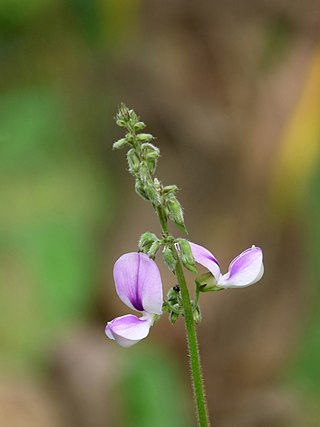
Pueraria is a genus of 15–20 species of legumes native to south, east, and southeast Asia and to New Guinea and northern Australia. The best known member is kudzu, also called Japanese arrowroot. The genus is named after 19th century Swiss botanist Marc Nicolas Puerari.

The Papaveraceae are an economically important family of about 42 genera and approximately 775 known species of flowering plants in the order Ranunculales, informally known as the poppy family. The family is cosmopolitan, occurring in temperate and subtropical climates, but almost unknown in the tropics. Most are herbaceous plants, but a few are shrubs and small trees. The family currently includes two groups that have been considered to be separate families: Fumariaceae and Pteridophyllaceae. Papaver is the classical name for poppy in Latin.

Panicoideae is the second-largest subfamily of the grasses with over 3,500 species, mainly distributed in warm temperate and tropical regions. It comprises some important agricultural crops, including sugarcane, maize, sorghum, and switchgrass.
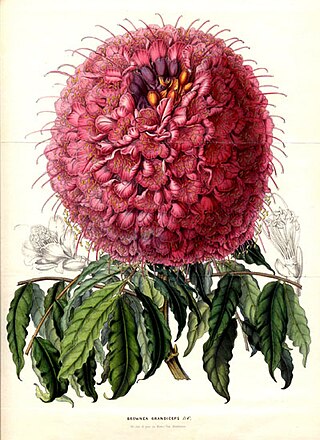
The subfamily Detarioideae is one of the subdivisions of the plant family Fabaceae (legumes). This subfamily includes many tropical trees, some of which are used for timber or have ecological importance. The subfamily consists of 84 genera, most of which are native to Africa and Asia. Pride of Burma and tamarind are two of the most notable species in Detarioideae. It has the following clade-based definition:
The most inclusive crown clade containing Goniorrhachis marginataTaub. and Aphanocalyx cynometroidesOliv., but not Cercis canadensisL., Duparquetia orchidaceaBaill., or Bobgunnia fistuloides(Harms) J. H. Kirkbr. & Wiersema.
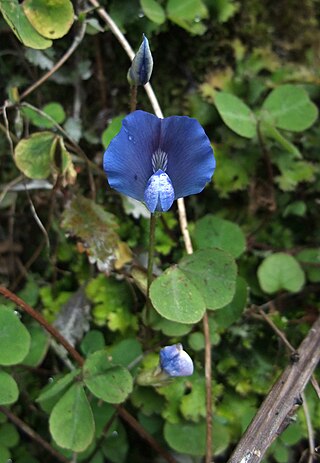
Parochetus communis, known in English as shamrock pea or blue oxalis, is a species of legume, and the only species in the genus Parochetus and in the subtribe Parochetinae. It is a low-growing plant with blue papilionaceous flowers and clover-like leaves. It is found in the mountains of Asia and tropical Africa, and has been introduced to New Zealand.
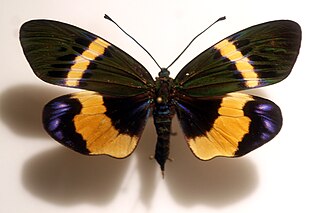
Chalcosiinae is a subfamily of the Zygaenidae, containing many species, mostly little known. Prominent sexual dimorphism, bright aposematic coloration and mimicry complexes are widespread.

Galegeae is a tribe in the flowering plant family Fabaceae, subfamily Faboideae. The tribe is found mostly in the northern hemisphere, but can also be found in Australia, Africa, and South America. Recent molecular phylogenetic work has determined that tribe Galegeae is paraphyletic, and that its members are scattered throughout the IR-lacking clade.

Oryzomyini is a tribe of rodents in the subfamily Sigmodontinae of the family Cricetidae. It includes about 120 species in about thirty genera, distributed from the eastern United States to the southernmost parts of South America, including many offshore islands. It is part of the clade Oryzomyalia, which includes most of the South American Sigmodontinae.

The tribe Fabeae is one of the subdivisions of the plant family Fabaceae. It is included within the Inverted repeat-lacking clade (IRLC). Five genera are included:

The tribe Dalbergieae is an early-branching clade within the flowering plant subfamily Faboideae. Within that subfamily, it belongs to an unranked clade called the dalbergioids. It was recently revised to include many genera formerly placed in tribes Adesmieae and Aeschynomeneae and to be included in a monophyletic group informally known as the dalbergioids sensu lato. The members of this tribe have a distinctive root nodule morphology, often referred to as an "aeschynomenoid" or "dalbergioid" nodule.
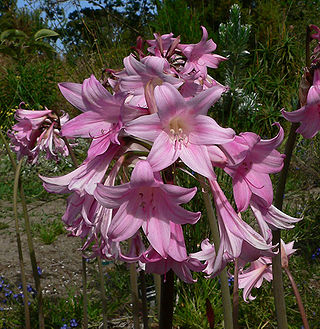
The Amaryllidaceae are a family of herbaceous, mainly perennial and bulbous flowering plants in the monocot order Asparagales. The family takes its name from the genus Amaryllis and is commonly known as the amaryllis family. The leaves are usually linear, and the flowers are usually bisexual and symmetrical, arranged in umbels on the stem. The petals and sepals are undifferentiated as tepals, which may be fused at the base into a floral tube. Some also display a corona. Allyl sulfide compounds produce the characteristic odour of the onion subfamily (Allioideae).

Amaryllidoideae is a subfamily of monocot flowering plants in the family Amaryllidaceae, order Asparagales. The most recent APG classification, APG III, takes a broad view of the Amaryllidaceae, which then has three subfamilies, one of which is Amaryllidoideae, and the others are Allioideae and Agapanthoideae. The subfamily consists of about seventy genera, with over eight hundred species, and a worldwide distribution.

The inverted repeat-lacking clade(IRLC) is a monophyletic clade of the flowering plant subfamily Faboideae (or Papilionaceae). Faboideae includes the majority of agriculturally-cultivated legumes. The name of this clade is informal and is not assumed to have any particular taxonomic rank like the names authorized by the ICBN or the ICPN. The clade is characterized by the loss of one of the two 25-kb inverted repeats in the plastid genome that are found in most land plants. It is consistently resolved in molecular phylogenies. The clade is predicted to have diverged from the other legume lineages 39.0±2.4 million years ago (in the Eocene). It includes several large, temperate genera such as AstragalusL., HedysarumL., MedicagoL., OxytropisDC., SwainsonaSalisb., and TrifoliumL..

Alioramini is a tribe of long-snouted tyrannosaurine tyrannosaurids from the Late Cretaceous epoch. It includes the tyrannosaurid genera Alioramus and Qianzhousaurus. Although tyrannosaurids are known from a variety of places around the globe, alioramins are currently restricted to Asia in mostly Maastrichtian strata.

The Antirrhineae are one of the 12 tribes of the family Plantaginaceae. It contains the toadflax relatives, such as snapdragons.

Wisterieae is a tribe of flowering plants in the bean family Fabaceae. The tribe was first described in 1994 for the sole genus Wisteria, but was greatly expanded in 2019 to include 13 genera, six of which were new. Five had previously been placed in the tribe Millettieae. Members of the tribe are climbers of various kinds. Some, like Wisteria, are cultivated for their flowers.
Villosocallerya bonatiana is a species of flowering plant in the family Fabaceae, native to south-central and southeastern mainland China, Laos and Vietnam. It is the sole species in genus Villosocallerya. The species was first described in 1910 as Millettia bonatiana.
















